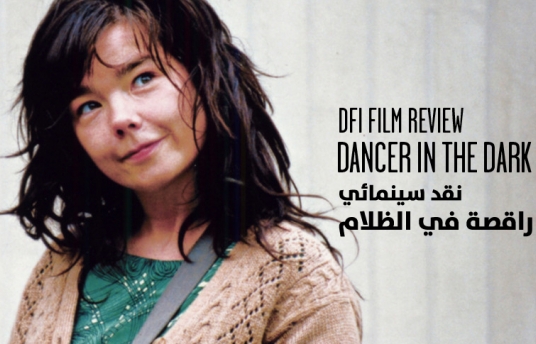DFI Film Review: Dancer in the Dark (2000)
Jul 24, 2011

Written by Reem Saleh, New Media, DFI
Film: Dancer in the Dark
Year: 2000
Director: Lars von Trier
Stars: Björk, Catherine Deneuve, David Morse
Genre: Drama, Musical
Set in 1964, Selma (Björk), an Eastern European immigrant, is working with a lot of devotion at a factory in the United States. She is saving every penny for an operation her son must have before the age of thirteen, otherwise he will go blind due to a genetic disease. She suffers from the same disease, and it is slowly but surely destroying her vision. Selma discovers however, that all the money she’s been working so hard to save has been stolen. Soon, a series of unfortunate events haunts this overly compassionate woman, whose only concern is her child’s operation. But when things get really bad, Selma copes by escaping into daydreams and imagining herself in a musical, because in musicals, according to her, “nothing dreadful ever happens”.
Danish director Lars von Trier brings us a touching picture dictated by the Dogme genre he masters so well. This is not surprising, since he is the co-founder of the Dogma 95 manifesto, which brought out an avant-garde film movement against very high budgeted films. Offering just a hint of criticism to Hollywood, something von Trier is famous for, the intention of this statement is to ‘purify’ films from expensive special effects and technology, allowing filmmakers to focus on drama and acting instead.
‘Dancer in the Dark’ is not completely true to Dogma 95 though, because the rules of this manifesto have been broken on many occasions, such as with the use of static cameras and enhanced colours. Instead, von Trier used genre-blended experimental methods that helped identify two distinct moods: the bitter reality of Selma, and her imaginary world.
It is filmed low-end, with one hundred digital cameras, in a documentary-style facade. Von Trier used this approach to accentuate the intimacy on screen, with a lot of hand-helds and close-ups, dragging you into the very core of the action and capturing intense emotions in a realistic manner. With so many cameras around, the actors are given the chance to concentrate without interrupting their role, allowing their emotions to develop.
You can notice it clearly when Kathy (Catherine Deneuve) covers her face to stop herself letting out a suffocated cry as she sees the nearly blind Selma using the railroad track to guide herself home, and in every facial expression of Selma when she is sad or dreamy.
It is very moving and disturbing, as is the reality of Selma, who is overly innocent, selfless and kind. This character is taken a step further by suffering the worst misfortunes that could occur to any human being, from living poorly within the toughest of conditions – ironically, in the land of her dreams – to her obsession with musicals that represent the best of America. Selma expected to live in songs that came from nowhere, filled with tap dancers and drums – like the films she grew up watching. Unfortunately, this fantastical world is only reachable through her imagination.
This brings us to the counter-style of brighter colours and fixed cameras that represent the daydream musical sequences of Selma. Suddenly, triggered by sounds around her, like the factory or the train, Selma escapes and becomes part of her own visions. Aesthetically, camera movements and frames are more established, colours are improved and sounds from her surrounding environment slowly develop into music. It is only when she escapes from reality that the score is used.
This film – that you might loathe or adore – drowned me in an inevitably disturbing yet enjoyable trip. I admit that I sobbed for a long time after it was over, so be prepared! It is emotionally provocative, smart and genuine. It cuts straight to your heart, if indeed your heart can take this powerful melodrama.
The winner of the Palme D’or and Best Actress award for Björk in Cannes 2000, this film is on my list of the best ever made.
Björk’s performance is as unique as her music. Her innocence, lines, expressions and emotionally engaging singing make it impossible for the viewer to be indifferent. This is truly the role of a lifetime that couldn’t have been performed by anyone else. The same could be said for Kathy, played by French Actress Catherine Deneuve, who is Selma’s best friend and co-worker, and who stands by her during every hardship. How warm it makes you feel when blind Selma goes to the cinema to watch a musical and Kathy takes her hand, imitating the tap dancing on screen with her fingers so Selma can imagine and feel the scenes. They have a powerful chemistry together, similar to a mother-daughter relationship, where Kathy’s presence brings comfort and affection to a lonely Selma. It is so real, you won’t feel like they are acting.
The soundtrack was composed by Björk, with some of the lyrics written by von Trier himself, showing a unique mix of talents from two experimental artists. Not only is the music amazing, but the lyrics also highlight the character of a very stoic Selma when she sings, while going blind: “I’ve seen it all, there is no more to see”.
It is a chef-d’oeuvre of modern cinema, with mixed opinions against this new genre. But no matter what you think of it, a fusion of rare emotions is guaranteed.
Dancer in the Dark - Trailer
إعلان فيلم راقصة في الظلام